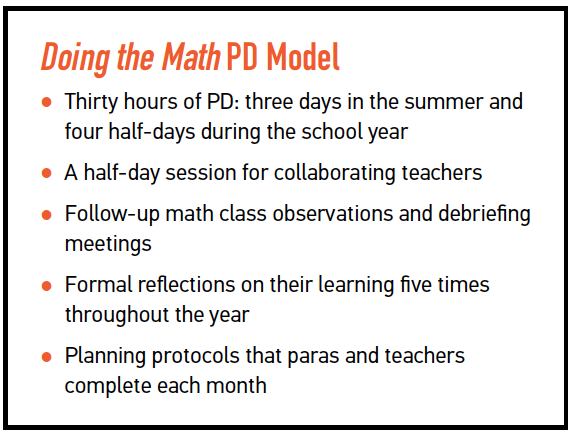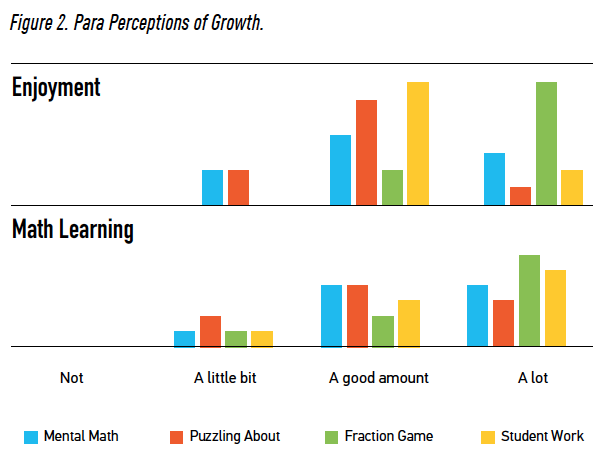Doing the Math with Paraeducators — Hands On! Winter 2018
By Judy Storeygard, Karen Mutch-Jones, Simone Ngongi-Lukula
Paraeducators (paras) are an important and underutilized resource with great potential to impact mathematics learning in elementary classrooms.
Evolution of the Paraeducator Role
Paraeducators (paras) are an important and underutilized resource with great potential to impact mathematics learning in elementary classrooms. Yet there is a widespread lack of preparation and support for them around subject matter knowledge, instructional strategies, and skills to address students’ different learning styles and needs. In one research study (Houssart, 2013), after being asked to teach a lesson on subtraction with no preparation or guidance, one para lamented, “I just taught them by demonstration … [I told students], ‘This is how you do column subtraction,’ and I just felt like the worst teacher in the world ever.”
Unfortunately, this para’s experience is not unique. Paras are paid by the hour for time spent with students only. They do not have regular access to the same curriculum resources as classroom teachers, or many opportunities to compare their challenges, strategies, and approaches. Further, the classroom teachers they work alongside seldom receive guidance about supervising and collaborating with paras (Ashbaker and Morgan 2012; Giangreco et al. 2012).
“Paraeducator” has replaced titles such as teacher aide, teaching assistant, instructional aide, and paraprofessional, in recognition that these professionals work alongside teachers. The National Resource Center for Paraeducators (NRCP) has noted that, at one time, paras’ roles ” … were limited to performing routine monitoring and clerical tasks.” Now, they “work with some of our most challenging students… [and] are being tapped to fill critical teacher shortages” (http://www.nrcpara.org/paranews). As the roles and responsibilities of paras have changed over many decades, there is a need for professional development that reflects their changing roles and growing need for math content knowledge, instructional strategies and learning communities.
Goals and Components of Doing the Math

In response to studies revealing that paras do not feel prepared for new instructional roles (Breton, 2010), and that they need opportunities that emphasize instructional strategies tied to mathematical concepts, curricular goals, and collaborative skills (Liston et al., 2009), we launched our NSF-funded Doing the Math with Paraeducators: A Research and Development Project (DRL 1621151). This professional development (PD) model is designed to increase paras’ confidence, knowledge of elementary math ideas, pedagogical strategies, and understanding of how students learn mathematics. We are working with Boston Public Schools paras in grades K-3.
In our PD model, paras are immersed in math content and pedagogy by doing, reacting, and reflecting on a variety of math problems and student work. Then, they analyze and understand the goals, strategies, and resources of the district mathematics program, by planning, engaging in, and analyzing math activities for students.
Successful Elements of the PD Model
Our first cohort completed the Doing the Math program in June 2018. Their ratings of their experiences and project researchers’ observations suggest several elements that can make a PD model responsive to and effective for paras. These include:
- Giving time and attention to creating a safe and encouraging learning environment: Paras need to learn in a context where they do not fear getting a “wrong” answer and can reveal their confusion about math ideas. Once this was established for our cohort, conversations were energetic and productive. Participants were eager to try out new strategies to solve math problems, as well as to share their knowledge, experiences, frustrations, and questions. Their confidence grew over the year; as one para expressed it (Figure 2):
“To meet other paras that [were] in the same boat as me. … really helped and encouraged that [work on math]. I feel a lot more secure about math than I did before.” - Providing paras with access to the math curriculum and opportunities to understand the curricular goals and philosophical-learning orientation: This support was especially important, since many paras do not have regular access to curriculum resources. Paras came away with a better understanding of the purpose of and how to teach unit resources, including math games. One teacher noted how the PD strengthened the instructional skills of a para in her classroom:
“She has grown and gained confidence in the material and in what math lessons are about. Last year she couldn’t have done a group on her own…Now she is confident.” - Providing opportunities to do math problems in ways that support math sense-making and enable them to reflect on how this approach differs from one that is procedural: For instance, paras began to comprehend that solving fraction problems involved more than memorizing a procedure. Rather, it was about understanding number relationships. Teachers working in the classroom with PD participants noted that this was an area of growth; for example:
“When discussing equivalent fractions, some kids were having trouble conceptualizing how two fractions can be different but take up the same amount of space inside of a whole. The para helped students to see the relationship by drawing pictures.”
Findings Related to Paraeducator Growth
During the year, we found that paras became more discerning and reflective about their own skills and needs over time. They reported high levels of enjoyment as they engaged in math teaching activities. At the same time, they honestly noted the challenges that lay ahead, rating their math learning slightly lower and their feelings of preparation to teach lower still. An example of this pattern related to specific PD topics is provided in Figure 2.

Furthermore, our data indicated that the paras formed a learning community that fostered professionalism and changed paras’ discourse about their students and their work. Having conversations about their students and working together on math instruction broadened paras’ perspectives about teaching and learning practices across classrooms and grade levels. It helped them think in new ways about working with students who need more support.
While the paras in the cohort appreciated that students learn at different rates, many didn’t understand what that meant in relation to specific math learning behaviors. Rarely had they been allowed to see specific information about student learning challenges. As a result, some assumed that students fit within two broad categories—those who have special needs and struggle with math and those who do not. Following PD, we discovered that the para cohort had developed a more nuanced awareness of student needs and appreciated the complexity of learning styles.
Next Steps for Doing the Math
Working with paras such as Natalia (see below) was a rewarding experience for our staff. She, along with other paras in the cohort, are helping to improve our model as we begin work with a new group. Many of them will serve as mentors to the 2018-19 para cohort and will facilitate analyzing student work sessions. Their feedback on and progress during Doing the Math points to the many ways that paras can be supported to build community, foster professionalism, strengthen instructional skills, and change their discourse about their work as educators. Their growth, enthusiasm, and insight underscores our recognition that paraeducators are a great, but underdeveloped, resource for mathematics learning in elementary classrooms.
Introducing Natalia
Natalia, a paraeducator who has been teaching Pre-K – Grade 4 for 22 years provides an example of para growth. Natalia’s ability to explain her own math problem-solving strategies, listen to her para colleagues, and admit her own confusions encouraged others to do the same. Ultimately, this contributed to building a learning community.
We saw evidence that Natalia applied what she had learned in the PD to her math teaching in order to accommodate the many ways in which students learn. For example, at a visit to her school one of our staff observed Natalia drawing the number line, a tool first introduced to her at a PD session, and using it as an instructional resource to help students solve problems. She told us that she would not have been able to use this approach prior to the PD.
During one session, Natalia shared her strategy for solving 62+38 efficiently, by changing the value of 62 to 60, and moving the 2 from the 62 over to the 38, making it 40. She explained that children would find it much easier to add 60+40 visually, than to see it written as 62+38. Just a few moments later she noted the importance of understanding a colleague’s method of mathematical problem solving.
Natalia also asked the students questions that promote mathematical thinking, another emphasis of the PD. These questions included, “Is there an easier way than counting by 1s?” and “Can you use fractions when talking about liquids?” She would then ask further questions, so that the students would have to explain their strategies for solving the math problem. If there was a mistake, Natalia would see it as a learning opportunity, not only for the students who volunteered to share their work, but also for the students in the classroom who were reluctant to explicitly seek help.
REFERENCES
Ashbaker, B. & Morgan, J. (2012). Team players and team managers: Special educators working with paraeducators to support inclusive classrooms. Creative Education 3(3), 322-327.
Breton, W. (2010). Special education paraprofessionals: Perceptions of preservice preparation, supervision, and ongoing developmental training. International Journal of Special Education 25(1), 34-45.
Giangreco, M. F., Doyle M. B., Suter, J. C. (2012). Constructively responding to requests for paraprofessionals: We keep asking the wrong questions. Remedial and Special Education 33(6), 362-373.
Houssart, J. (2013). “Give me a lesson and I’ll deliver it’: Teaching assistants’ experiences of leading primary mathematics lessons in England. Cambridge Journal of Education 43(1), 1-16.
Liston, A.G, Nevin, A. and Malian, I. (2009). What do paraeducators in inclusive classrooms say about their work? Analysis of national survey data and follow-up Interviews in California. Teaching Exceptional Children Plus 5 (5), 2-17. Retrieved from: http://files.eric.ed.gov/fulltext/EJ967750.pdf
